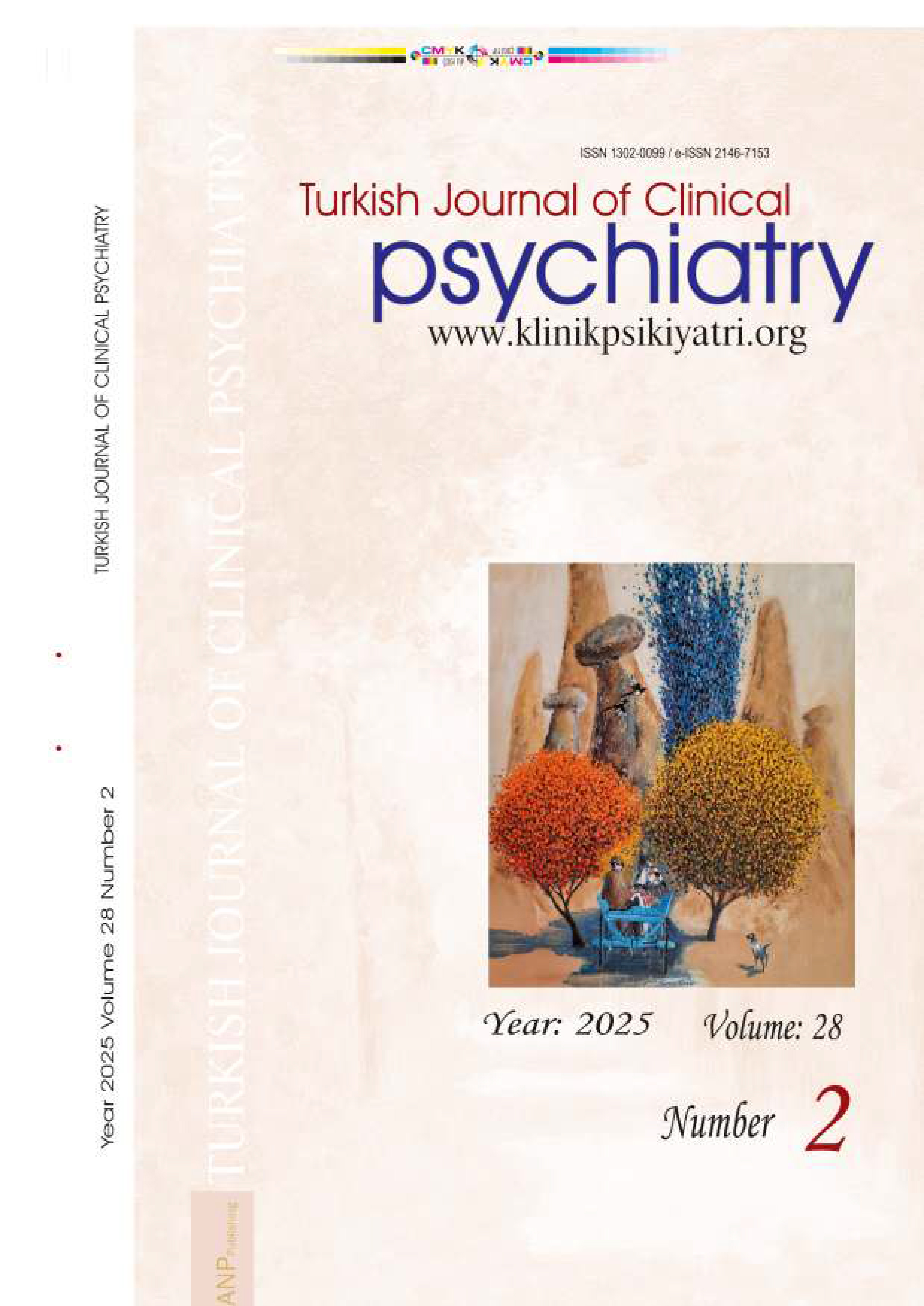





Volume: 8 Issue: 1 - 2005
| RESEARCH ARTICLE | |
| 1. | The Place of Wechsler Intelligence Scale for Children-Revised in Assessment of Attention Deficit Hyperactivity Disorder Emel Erdoğan-Bakar, Şebnem Soysal, Nurcihan Kiriş, Aynur Şahin, Sirel Karakaş Pages 5 - 17 Objective: The present study analyzed WISC-R scores that were obtained from a sufficient number of ADHD patients and matched control subjects under controlled conditions. This study was realized as a multi-center project. Methods: The clinical sample consisted of 105 male patients (age range: 6-16 years). The control group consisted of 90 male subjects who were matched with the ADHD sample. WISC-R was individually administered to the subjects by three testors who had the relevant training for WISC-R administration. Results: Principal component analysis showed that the factor structure of the control group included separate factors for verbal subtest scores, performance subtest scores and coding score. The factor sructure of the ADHD group was disorganized. Multivariate analysis of variance showed that the group variable (ADHD, control) was significant. The significantly affected scores that included General Information, Arithmetic, Block Design and Coding subtests were subjected to logistic regression analysis. The only score that the regression model included was Digit Symbol. The accuracy of prediction for the total model was a low value, 63.08%. These results showed that WISC-R scores misclassified 40 of 90 healthy subjects as DEHB and 32 of 105 DEHB patients as healthy. Discussion: Clinical diagnosis that are made with hit rates such as those obtained using WISC-R scores may, most probably, not have any clinical value. The findings of the present study show that the place of WISC-R in assessing DEHB patients should be carefully reconsidered. |
| 2. | Personality Disorders in Parents of Children with Attention Deficit Hyperactivity Disorder Oya Güçlü, Murat Erkıran Pages 18 - 23 Objectives: The purpose of this study is to investigate DSM-IV personality disorders, adult ADHD and alcohol use in mothers and fathers of children followed up with attention deficit hyperactivity disorder (ADHD). Method: The samples were consisted of the parents of 118 children with attention deficit hyperactivity disorder (ADHD) and 115 children with enuresis nocturna (EN). For the assesment semi-structured socio demographic form, Turgay ADHD scale and SCID-II were used. Results: The rates of borderline personality disorder (%1.3), borderline personality traits (%3.4,) obsessive compulsive personality disorder (%19.9) and antisocial personality disorder (%8.1) in parents of ADHD children were found statistically significantly higher than the parents of EN children. In parents of ADHD children %24 of were social drinker, %9.7 of were alcohol abuser and only %1.7 of were alcohol dependent. Only antisocial personality disorder were found statistically significantly higher in parents with alcohol use. There is no statistically significant difference between parents with adult attention deficit hyperactivity disorder and the parents without ADHD according to their personality disorder and alcohol use. Conclusion: We have concluded that; attention deficit hyperactivity disorder effects both the children and the parents. In handling an ADHD child, considering the parents psychopathology and treatment supposed to be constructive for childs treatment. |
| 3. | The Investigation of Duchenne Muscular Dystrophy Children's Family Functions and their Mothers' Depression and Anxiety Levels Burcu Çakaloz, Semra Kurul Pages 24 - 30 Objectives: Duchenne Muscular Dystrophy is a chronic disease that is emotionally wearing out for both the child and the family. The aim of the study is to investigate the mental status of mothers of children with Duchenne Muscular Dystrophy and their family functions. Method: 17 children being followed with diagnosis of Duchenne Muscular Dystrophy and 32 children's mothers who are vounteer and healty were admitted to this study, in Dokuz Eylül University Faculty of Medicine, Department of Pediatrics. The children's mothers of both groups were given Beck depression inventory, State-Trait Anxiety Inventory, family assessment device and short questionnaire enquiring demographic information. Results: Mothers of the children with Duchenne Muscular Dystrophy had significantly higher Beck Depression Inventory and State-Trait Anxiety Inventory scores were compared to mothers of the control group. Comparing control group and the mothers of the patient group, there were significantly different results between two groups in subsection of affective responsiveness of family assesment device. Conclusion: This study demonstrated that, for mothers who have children with Duchenne Muscular Dystrophy, Duchenne muscular dystrophy had an adverse effect on their lives, and their family relationships. It is suggested that mothers of children with Duchenne Muscular Dystrophy should be given a regular psychological support. |
| 4. | The Reliability and Validity of Turkish Form of the Symptom Interpretation Questionnaire Hüseyin Güleç, Kemal Sayar Pages 31 - 36 Objective: In this study, it is aimed to reliability and validity of the Symptom Interpretation Questionnaire (SIQ) that was developed by Robbins and Kirmayer was investigated in Turkish population. Method: The study was carried out with 107 patients attending to outpatient psychiatry clinics, FTR clinics and nonseek FMS patients and 86 healthy students from Karadeniz Technical University (KTU). University students were assessed one mounth later for test- retest reliability. Results: A high correlation level was obtained for the subscales (r=0.74 for psychologizing, 0.56 for somatiz- ing and 0.72 for normalizing) score. All items showed enough positive correlation in the test-retest analysis (r< 0.30). Internal reliability of SIQ subscales were, alpha: 0.82 for psychologizing subscale, alpha: 0.76 for soma- tizing subscale and alpha: 0.82 normalizing subscale. The validity analysis of the subscales resulted in an enough significant difference (p=0.025) between total scores of the healthy control and patient with major depressive disorder. Validity of somatizing subscale was demonstrated by obtaining higher significant (p=0.001) mean somatizing subscale scores in FMS patient reached from FTR clinics when compared mean scores with healthy control. But highest significant difference obtained between mean scores in unseek FMS patient and healthy control (pcO.001). Discussion: The results of this study indicated that this scale has satisfactorily reliability and validity for the Turkish population and SIQ will provide important knowledge for researchers about especially "patient" with medically unexplained complaints and nonseek "healthy" groups. |
| REVIEW | |
| 5. | Dementia of Alzheimer Type-Related Changes in Cognitive Processes Handan Can, Sirel Karakaş Pages 37 - 47 In this article, changes appeared in cognitive processes in the dementia of Alzheimer type are reviewed. In the dementia of Alzheimer type, these changes occured in brain structure also cause several psychological changes. Psychological disorders include emotional and cognitive impairments. In this article, disordered cognitive areas in the dementia of Alzheimer type such as memory, attention, language, visual-spatial and executive functions and their sub-components were explained in detail and changes occured in these cognitive areas parellel with the dementia of Alzheimer type progression were examined. Parellel with the dementia of Alzheimer type progression, several changes in the mentioned cognitive areas are seen. In the ongoing progression with time, several disorders related to the dementia of Alzheimer type in short-term memory and sensory-motor performance are observed too and in the worst stages of the disease, aphasias and agnosias are seen. When the studies in the literature are examined, it is seen that different staging scales have been used in the Dementia of Alzheimer Type. It is very important to use an appropriate staging scale before making a detailed neuropsychological assessment of the changes in cognitive processes. Another factor that must be paid attention is the necessity of examining the mentioned changes in cognitive processes with their subcomponents in details. However, all of cognitive processes and their subcom- ponets are not impaired at the same time in the Dementia of Alzheimer Type. For this reason, changes observed in cognitive processes in the dementia of Alzheimer Type should be dealt with in detail. |










